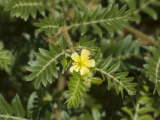Recent livestock disease investigations in WA
Bluetongue excluded in Wheatbelt sheep
- A producer reported that 20 from a mob of 400 Merino wethers grazing stubble were showing signs of acute eye infections, appeared blind and had crusting mouth lesions (see Figure 1 below).
- Half of the animals had a purulent ocular discharge with severe blepharospasm and swelling of the face and periorbital tissues, which caused them to appear blind. Blackened, leathery skin on the eyelids and ears indicated necrosis, and the animals were jaundiced (Figure 2).
- A provisional diagnosis of unusually severe photosensitisation was made, possibly associated with caltrop toxicity as the plant was found in the paddock (Figure 3).
- Testing identified a hepatopathy and nephropathy, consistent with caltrop toxicity, which can lead to secondary photosensitisation and bacterial eye infections.
- Testing of blood and liver samples helped to rule out the exotic disease bluetongue. In the acute stage, sheep with bluetongue may have pyrexia, salivation, a nasal discharge causing crusting around the nostrils, swollen lips and tongue which may extend to include the ears, and petechial haemorrhages of the mucous membranes of mouth, nose and eyes. Lameness associated with laminitis may also be seen.
Neurological signs in dairy calves in the South-West
- Neurological signs were reported in 3-month-old, mixed sex dairy calves with 5 dead and 2 affected from a group of 19. The calves were ataxic and disorientated with a wide-base stance. One severely affected calf collapsed and showed paddling prior to death.
- The calves were on a milk and hay diet, and no other animals on the property were affected.
- The vet suspected annual ryegrass toxicity (ARGT), botulism or contamination of water by blue-green algae.
- Key samples submitted included hay, water, faeces, blood and a base sample set.
- All faecal samples and one rumen content sample were positive for ARGT antigen, confirming exposure. Quantitative hay testing indicated a high risk for ARGT, which suggests that clinical disease is likely if hay forms a substantial part of the calves’ diet. One calf had lesions typical of ARGT in the cerebellar meninges.
- Bacterial culture of the brain was negative for pathogenic organisms, and lead toxicity was ruled out given no supportive histopathological lesions were found. Neither botulinum nor blue-green algae toxins were found.
- The findings supported a diagnosis of ARGT. The water sample tested showed salinity levels potentially too high for dairy calves. This information will aid the producer to avoid production losses associated with water quality.
- Read more on how to prevent ARGT in livestock.
Diseases to look out for in late summer/early autumn
| Disease, typical history and signs | Key diagnostic samples |
|---|---|
| Ewe abortion
| Talk to producers about the DPIRD ewe abortion and newborn lamb deaths surveillance program where producers can collect and freeze samples when deaths occur, and send them to DPIRD when they have 3 or more deaths. Sampling guide and submission forms are available on the webpage. |
| Salmonellosis in sheep
| Antemortem
Postmortem
|
| Grain overload in stock
| Postmortem
|
Farm biosecurity and lamb deaths surveillance information at Woolorama
Farm biosecurity will be in the spotlight at Woolorama with DPIRD partnering with Livestock Production Assurance (LPA) and Livestock Biosecurity Network to provide information on recent changes to LPA accreditation, including farm biosecurity plans and animal welfare. Read more about the farm biosecurity hub at Woolorama. Veterinarians who wish to assist clients to investigate the cause of death in pre-term and newborn lambs can pick up a free sampling esky and information about the lamb deaths surveillance scheme.
For the latest in farm biosecurity information, come to the DPIRD shed, lot 626, Kitchener St, Woolorama on 9-10 March.
Livestock disease investigations underpin WA’s livestock markets
Australia’s ability to sell livestock and livestock products depends on evidence from our surveillance systems that we are free of livestock diseases that are reportable or affect trade. Data from livestock disease investigations provide evidence that WA is free from these diseases and supports our access to markets.
Previous issues
Previous issues of WALDO - for vets and WALDO - for producers are available on the DPIRD website on the newsletter archive page or by searching 'WA livestock disease outlook - for vets'.
Feedback
We welcome feedback. To provide comments or to subscribe, email waldo@dpird.wa.gov.au

